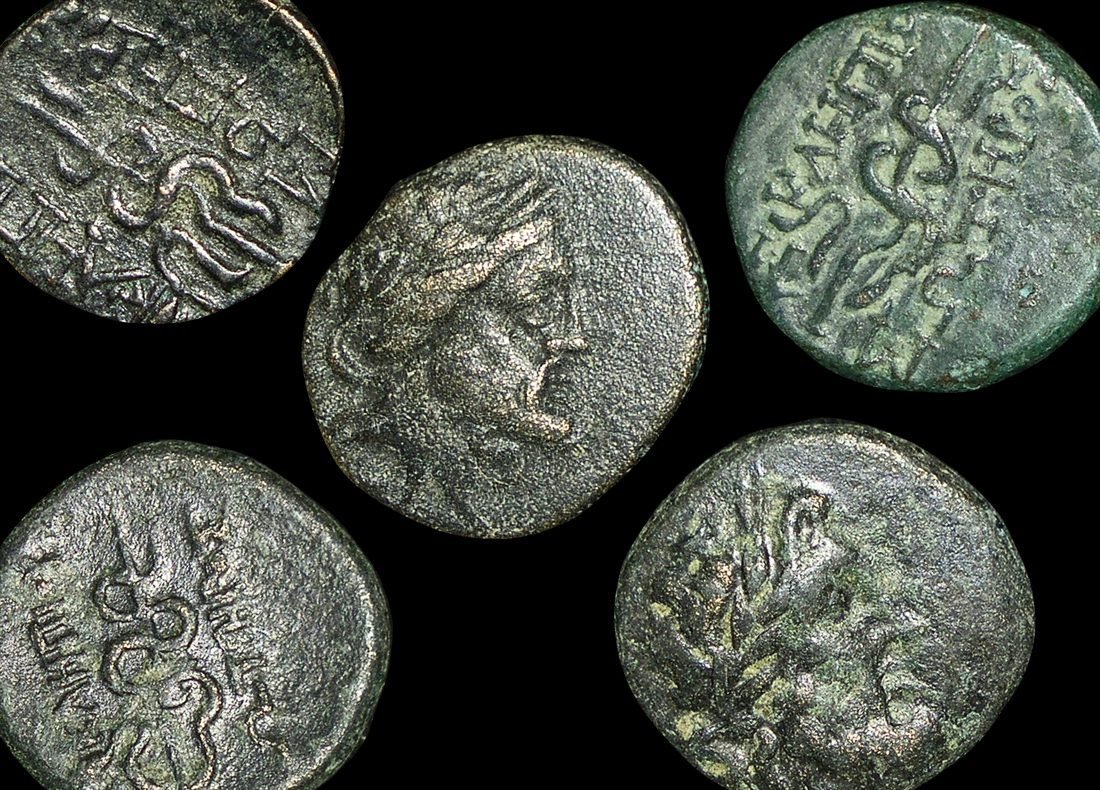 Image 1 of 2
Image 1 of 2

 Image 2 of 2
Image 2 of 2



Sicilian Bronze Coin from Himera featuring Gorgon (about 2430 years ago)
This bronze coin was minted between 415-410 BC in Himera, an ancient Greek colony on the northern coast of Sicily (modern Italy).
Front Side: Features a facing Gorgon head (mythological creature with snakes for hair whose gaze turned onlookers to stone)
Back Side: Displays 6 pellets (dots representing value)
Technical Details:
Weight: 17.22 grams
References: SNG ANS 179-180
Historical Significance: This coin was minted during the final years of Himera's existence. The city was completely destroyed by Carthaginian forces in 409 BC during the Second Sicilian War, making this one of the last coins produced there. The Gorgon image was meant to be apotropaic (warding off evil), a fitting symbol for a city under threat. The simple reverse with pellets indicates the denomination in a system understood by local users. Coins from this brief final period of Himera's history are important archaeological evidence of Greek Sicily's turbulent relationship with Carthage.
This bronze coin was minted between 415-410 BC in Himera, an ancient Greek colony on the northern coast of Sicily (modern Italy).
Front Side: Features a facing Gorgon head (mythological creature with snakes for hair whose gaze turned onlookers to stone)
Back Side: Displays 6 pellets (dots representing value)
Technical Details:
Weight: 17.22 grams
References: SNG ANS 179-180
Historical Significance: This coin was minted during the final years of Himera's existence. The city was completely destroyed by Carthaginian forces in 409 BC during the Second Sicilian War, making this one of the last coins produced there. The Gorgon image was meant to be apotropaic (warding off evil), a fitting symbol for a city under threat. The simple reverse with pellets indicates the denomination in a system understood by local users. Coins from this brief final period of Himera's history are important archaeological evidence of Greek Sicily's turbulent relationship with Carthage.
This bronze coin was minted between 415-410 BC in Himera, an ancient Greek colony on the northern coast of Sicily (modern Italy).
Front Side: Features a facing Gorgon head (mythological creature with snakes for hair whose gaze turned onlookers to stone)
Back Side: Displays 6 pellets (dots representing value)
Technical Details:
Weight: 17.22 grams
References: SNG ANS 179-180
Historical Significance: This coin was minted during the final years of Himera's existence. The city was completely destroyed by Carthaginian forces in 409 BC during the Second Sicilian War, making this one of the last coins produced there. The Gorgon image was meant to be apotropaic (warding off evil), a fitting symbol for a city under threat. The simple reverse with pellets indicates the denomination in a system understood by local users. Coins from this brief final period of Himera's history are important archaeological evidence of Greek Sicily's turbulent relationship with Carthage.
Near the site of the first battle and great Carthaginian defeat of 480 BC, the Second Battle of Himera was fought near the city of Himera in Sicily in 409 between the Carthaginian forces under Hannibal Mago (a king of Carthage of the Magonid family, not the famous Hannibal of the Barcid family) and the Ionian Greeks of Himera aided by an army and a fleet from Syracuse. Hannibal, acting under the instructions of the Carthaginian senate, had previously sacked and destroyed the city of Selinus after the Battle of Selinus in 409. Hannibal then destroyed Himera which was never rebuilt. Mass graves associated with this battle (along with the first Battle of Himera in 480 BC) were discovered in 2008-2011, corroborating the stories told by ancient historians.[1]
Phoenicians of Western Sicily had aided the Elymians against the Dorian Greeks of Selinus in 580 when a Greek colonization attempt of Lilybaeum was defeated.[2] The invasion of Spartan Dorieus was again defeated by Carthage near Eryx in 510, and a war followed where Carthage destroyed the city of Hereclea Minoa.[3] Carthage signed treaties with the cities of Selinus, Himera, and Zankle by 490. The pretext for launching the Punic Sicilian expedition of 480 was the restoration of the deposed tyrant of Himera. The Sicilian Greeks under the tyrants Gelo of Syracuse and Theron of Akragas had crushed the Punic expedition in the 1st battle of Himera in 480 BC.
Carthage had stayed away from Sicilian Greek affairs following the defeat for 70 years, during which time Greek culture started to penetrate the Elymian, Sikanian, and Sicel cities. The political landscape in Sicily also changed as Greek tyrants were replaced by democracy and oligarchy, the domain of Syracuse shrunk, and infighting between Greek cities flared up in Sicily. Athens had sent fleets to Sicily in 427, 425, and 424 to intervene, which caused Hermocrates of Syracuse to request all Sicilian Greek cities to remain at peace at the congress of Gela in 424.
You Might Also Like











